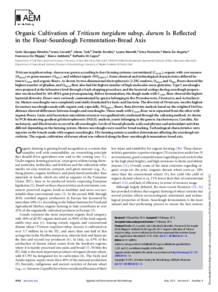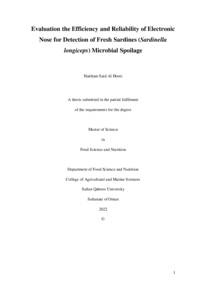Document
Organic cultivation of triticum turgidum subsp. durum is reflected in the flour-sourdough fermentation-bread axis.
Identifier
DOI: 10.1128/AEM.04161-14
Contributors
Cavoski, Ivana., Author
Turk, Jelena., Author
Ercolini, Danilo., Author
Nionelli, Luana., Author
Pontonio, Erica., Author
Angelis, Maria De., Author
Filippis, Francesca De., Author
Gobbetti, Marco., Author
Cagno, Raffaella Di., Author
Publisher
American Society for Microbiology.
Gregorian
2015-05
Language
English
English abstract
Triticum turgidum subsp. durum was grown according to four farming systems: conventional (CONV), organic with cow manure (OMAN) or green manure (OLEG), and without inputs (NOINPUT). Some chemical and technological characteristics differed between CONV and organic flours. As shown by two-dimensional electrophoresis (2-DE) analysis, OMAN and OLEG flours showed the highest number of gliadins, and OMAN flour also had the highest number of high-molecular-mass glutenins. Type I sourdoughs were prepared at the laboratory level through a back-slopping procedure, and the bacterial ecology during sourdough preparation was described by 16S rRNA gene pyrosequencing. Before fermentation, the dough made with CONV flour showed the highest bacterial diversity. Flours were variously contaminated by genera belonging to the Proteobacteria, Firmicutes, and Actinobacteria. Mature sourdoughs were completely and stably dominated by lactic acid bacteria. The diversity of Firmicutes was the highest for mature sourdoughs made with organic and, especially, NOINPUT flours. Beta diversity analysis based on the weighted UniFrac distance showed differences between doughs and sourdoughs. Those made with CONV flour were separated from the other with organic flours. Lactic acid bacterium microbiota structure was qualitatively confirmed through the culturing method. As shown by PCR-denaturing gradient gel electrophoresis (DGGE) analysis, yeasts belonging to the genera Saccharomyces, Candida, Kazachstania, and Rhodotorula occurred in all sourdoughs. Levels of bound phenolic acids and phytase and antioxidant activities differed depending on the farming system. Mature sourdoughs were used for bread making. Technological characteristics were superior in the breads made with organic sourdoughs. The farming system is another determinant affecting the sourdough microbiota. The organic cultivation of durum wheat was reflected along the flour-sourdough fermentation-bread axis.
Member of
ISSN
0099-2240
Resource URL
Category
Journal articles


